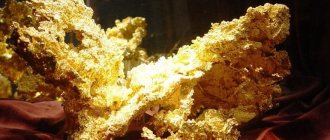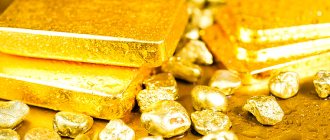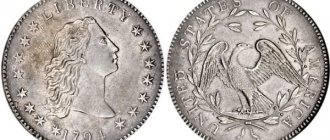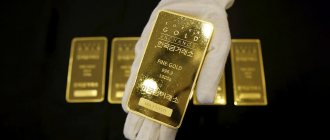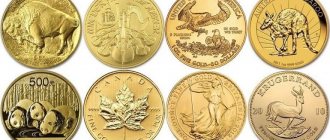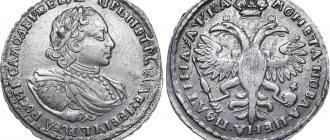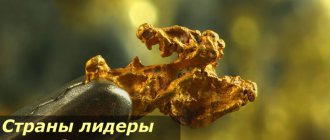Now it is difficult to say which nugget was the largest in history. The fact is that there is not information about all the pieces found, because they were often melted down in the past, and data about them was not preserved. Information about some nuggets has now reached us only in the form of legends and myths, while others have been preserved and have documentary evidence. What was the largest gold nugget in the world?
Australia's largest nugget
In order to figure out which nugget was the largest in the world, you need to understand what is meant by this word. The fact is that gold in nuggets is not always pure; it can have inclusions of silver, quartz and other metals. Nevertheless, such gold will be called native.
Nuggets are mined both in placer deposits and in mines. And geographically the largest of them were discovered in Australia. It turns out that this continent is extremely rich in precious metal.
What is a gold nugget: it is, composition, what it looks like, structure
Pure gold of the highest standard is rare in nature. Most often, the precious metal is part of ores, minerals, and is sometimes present in river sand. Native gold - a piece of precious metal with a minimum of impurities - is a rare and valuable find. It contains impurities of various metals and minerals (up to 20%). The color of gold depends on the composition of impurities. Native metal can have a color from white to yellow in all shades.
If the ingot has a lot of copper, then it has a pinkish tint.
Golden Nugget
Normandy Nugget (Pepita de Normandy)
The fourth largest gold nugget found in the world is the 25.5 kg (820 oz) Norman Nugget, which was found in Western Australia's major mining center of Kalgoorlieve. It is estimated to be between 80 and 90% pure.
In 2000, the nugget was acquired by Normandy Mining, which is now owned by Newmont Gold Corporation. It is on display at the Perth Mint Museum thanks to an agreement between the mining company and the Australian Mint.
Western Australia is one of the country's most important mining regions. The Kalgoorlie region is currently home to the Super-pit mine, Australia's largest.
The story of the first gold nugget in Rus'. The phenomenon of the "gold rush" of the mid-19th century
Despite the fact that gold products in Rus' began to be made since ancient times, imported noble metal was used. The fact that the Russian land is rich in gold deposits was known from ancient historical sources. Finished gold items were found at the settlement sites of the ancient Slavs. 1745 is the year when native gold was discovered in the Urals, and two years later the first mine, the Initial mine, was opened on this site.
The 19th century is known for the beginning of the so-called gold rush in Alaska. Dreaming of fabulous wealth, prospectors left their homes and risked their lives.
The gold rush also did not spare Russia. Since the beginning of the 19th century, prospectors tried to conquer Siberia and the Far East, Kuzbass and Tom.
XIX-XX century. The end of the “fever” and a new wave
Competition among miners was growing.
Industrialists were nervous, fought for mines and cheap labor, and paid bribes to officials to get permission for new production. The deposits were quickly destroyed - the gold was collected “at the top” and abandoned. Production gradually fell. In the record year of 1847, one province produced 1,305 pounds of gold, and in 1863, the entire Eastern Siberia produced only 714 pounds.
Soon the “fever” ended: everything that could be mined by hand was mined. The owners of the mines simply gave them to contractors, and to those who were lucky, they rented them out. The industry became smaller, and only small mines and miners' artels remained. Geological exploration was completely abandoned. “...There were only two people capable of distinguishing rocks at least in rough terms,”
- writes the book “Gold of Siberia” about the end of the century before last. It became unprofitable to develop mines manually.
Although there was great luck. In 1898, two prospectors, Tarkhan and Belov, quite by accident found the largest nugget in Central Siberia, the “Bull’s Head”,
weighing 31.6 kg!
At the end of the shift, the workers went into the workings to clear the rock. One touched a lying stone with a pick, the other tripped over it - and they saw the trace of the impact flash with yellow light. Never before had such luck fallen into their hands.
They decided to steal the nugget - they hid it behind the support (an arch that is placed so that the excavation does not collapse). With joy, they drank for a week, and during the binge, one blabbed to his wife about the valuable stone. She couldn’t hide the secret either.
The next morning the nugget was seized by the mountain guards. But the co-owner of the mine was incredibly happy with the find. He did not punish the workers and even paid a lot of money - 2 thousand rubles. According to legend, the money was drunk again.
After the end of the “fever”, industrial gold mining began in the region
— large enterprises emerged, based on serious geology and mechanical engineering. The first dredges, which had long been used in America and Australia, were brought to the Yenisei province. A dredge is a floating “excavator” that takes soil from great depths of gold-bearing rivers, washes it, replacing hundreds of miners.
The largest number of dredges in Russia were installed on our Uderey River (the first was at the Californian mine). By 1910, 33 dredges were operating in the province, more than half of all available in the country. By 1917, 18 joint-stock enterprises operated at the mines.
With new technologies, the industry has become profitable again.
In 1916, local industrialists announced plans for the future - to conduct geological exploration throughout the province, to create their own industry bank, which would finance the construction of mines, refineries, roads, and telegraph lines. They wanted to build a railway deep into the taiga, build a bridge across the Yenisei near Yeniseisk, and open a technical institute in Krasnoyarsk. But the revolution got in the way.
Why is the metal often confused with pyrite? What geologists say about gold nuggets
With the onset of the gold rush, ships filled with pyrite sailed from America to Europe. Due to its external resemblance, this breed was often confused with gold. In fact, pyrite is iron pyrite, also called fool's gold or the stone of madmen. Gold and pyrite can be distinguished by several characteristics:
- Form. Pyrite is a crystal-shaped stone with sharp edges; gold has soft, rounded edges.
- Smell. Pyrite contains more than 50% sulfur, so it has a specific rotten smell. Noble metal has no odors.
- Size. Pyrites can occur in different sizes. Gold is more often found in bulk, less often in small pieces, and even less often in large ingots.
- Hardness. Noble metal is very soft and malleable, so a ligature is used to make jewelry or other products. A gold bar can easily be pierced with a needle and can be tasted on the tooth. Pyrite is hard.
Gold nuggets
Pyrite and gold are similar in color, brilliance, and density.
Geologists studied the similarities between the two rocks:
- A. Betekhtin “Pyrite group. Mineralogy Course";
- K. Gurlitt “Manual Mineralogy”;
- A. Smolin “Golden nuggets of the Urals”.
Only centuries later, pyrite ceased to be known as a deceiving stone, and people learned to use its beneficial properties.
Table: characteristics of native gold
What samples are classified as nuggets? A gold nugget is considered to be a single ingot, the minimum weight of which must reach 2 grams. There are known cases when nuggets weighing almost a hundredweight were found.
Native gold has the following characteristics:
| Property | Description |
| Color | Thick yellow, giving off a silvery sheen. It can fade and become brighter, acquire shades: white, pinkish, greenish, reddish. |
| Transparency | Absent |
| Shine | Metal |
| Surface | It can be either smooth or rough. There are notches and grooves. Often a nugget is found “jacketed,” that is, the piece is covered with some other rock. |
| Hardness | Noble metal is very soft. Mohs scale 2.5-3 |
| Form | There is no need to expect complete symmetry in the outline of a piece of gold bar. It may look like a geometric shape, an animal, a plant, a flat leaf, a feather, or a branch. |
| Try | From 800-950. A gold nugget contains minimal impurities. For example, metal of 585 standard cannot be considered native. |
Hypotheses for the formation of gold nuggets
There are several theories about where gold nuggets come from in the ground.
- Snowball. Gold is a very soft and malleable metal. The golden particles, moving and connecting with each other, stick together, like snowflakes forming a snowball.
- Sediment. Since gold is heavier than water, it sinks down. Gold particles are layered on top of each other until a nugget is formed.
- Large gold stones can fall apart under external influences. Such gold nuggets are very rarely found in nature.
- Blur. Many ancient gold deposits may be located in river or stream beds. The remains of gold veins are washed away by currents.
- Upper layer. All nuggets are located on the upper layers of ore. It has been proven by geologists that these places will definitely have gold deposits.
Nugget “Welcome Stranger”: the story of the discovery
A copy of The Desired Stranger
In February 1869, two British gold miners, John Deason and Richard Oates, were excavating in central Victoria when their pick struck something very hard near the surface of the earth.
According to another story, they were trying to pull a stuck cart wheel out of a hole. When Deason bent down to examine a large rock that he thought was interfering with his search, he discovered a nugget. It became the largest find of pure gold that people have ever seen and will ever see in the future. The nugget was 60 cm long and almost 30 cm wide.
Endogenous origin of gold nuggets. Locations of nuggets today
One theory is that native gold is of endogenous origin. That is, it is formed in the bowels of the earth at a depth of several kilometers.
Today nuggets can be found in the following places:
- Gold-bearing veins up to 10 cm thick. Veins are cracks in the earth’s crust that are filled with ore. The thickness, that is, the thickness of the vein, can reach several tens of meters, but also several centimeters. Veins up to 10 cm thick are called veinlets and are often of no interest to gold miners, although precious metal can be mined there.
- Areas with active metal precipitants. Sulfites, quartz, and coal contribute to gold sedimentation. Therefore, areas with these rocks may well have nuggets.
- Mountain streams, dry streams. Precious metal flows into streams from mountain slopes. Because gold is heavy, it settles to the bottom.
- Depleted deposits. Geologists often conduct searches on an industrial scale. When large gold reserves are identified, prospecting ends. But small particles and nuggets of precious metal may remain there.
You can learn about the localization of gold deposits from the works and stories of geologists, as well as from old-timers of the area.
Gold mining - gold nuggets
The most famous deposits of gold nuggets found in Russia, photos without processing
According to geological maps, the largest gold deposits are concentrated in the territories of the Far East, the Urals, and Siberia. But it is not possible to find native precious metal everywhere.
- Natalka or Natalka gold-quartz deposit. The name is derived from the name of the daughter of the discoverer-geologist D. Aseev, Natalya. Located in the Omchak River basin, 390 km from Magadan.
- Nezhdaninskoye field. Located in Yakutia, in the Aldan River basin. The mine, discovered in the 50s of the last century, marked the beginning of the opening of the village of the same name.
- Olimpiadinskoye and Blagodatnoye. The largest deposits are located in the Krasnoyarsk Territory at a distance of 25 km from each other.
- Darasun gold deposit. Location: Trans-Baikal Territory, Chita region. The development of Darsun began 160 years ago.
- The Tash-Targanka River flows in the territory of Miass in Bashkiria. Now gold is not mined here, but literally 200 years ago Tash-Targanka produced so many nuggets that a gold-mining plant had to be opened in Miass.
- The moss swamp is located in the South Ural region, Chelyabinsk region. Gold is found here in bulk. The Bolsheshaldinskaya placer deposit is also located here.
- Sverdlovsk quarries. The main Ural gold deposits are concentrated in the Sverdlovsk region. Of these, 75% are placers. The Kamushki quarries are located 50 km from Yekaterinburg. Since the century before last, prospectors have been searching for precious metal here.
- Kajaran and Sotskoye fields of Armenia. Gold deposits located near the cities of Sotsk and Kajaran were discovered and developed under Soviet rule.
Soviet authority
In the first years of the new government, all industrial production declined.
Gold mining too: enterprises were closed, dredges were confiscated, broken or flooded. The Gubispolkom Bolsheviks took and removed gold bars from the state banks of Krasnoyarsk and Minusinsk so that they would not go to the whites and other Bolsheviks.
But any government needs money, and in the twenties they began to restore the fishery. Now on a state basis - they created a trust, then the Yeniseizoloto association, which became a natural monopolist. Illegal miners were caught, tried and given a year in prison for every gram found on them. But those who mined a lot could pay it off - there were plenty of such stories.
In 1924, Yeniseizolot drew up the first work plan for 5 years (in the rest of the USSR, “five-year plans” appeared only in 1928). We started building the infrastructure - we created it. Now it makes ballistic missiles, but then it produced dredges, steam boilers and excavators for the mining industry.
During the Great Patriotic War, pensioners, teenagers and thousands of women came to the mines. The wives of front-line soldiers and housewives learned to drill and blast rock and went to work as miners, loaders, and electric locomotive drivers. The machines were worn out to the limit, but the women's teams exceeded plans by 150%. Although they mined less gold. In 1945, experienced workers returned to the mines, and production immediately increased.
After the war, Yeniseizoloto reconstructed existing mines and factories and introduced new technologies. It was their enterprises that developed vast territories - they built power lines, roads, and communications on the lands of what is now the North Yenisei and Motyginsky districts.
In 1975, the Olimpiadinskoye field, the largest in the region, was discovered in the North Yenisei region. The first gold was found there back in the 60s. Then geologist L.V. Lee spent a long time proving to officials that a lot of gold ore could be mined here. In ’74 they equipped an expedition, in ’75 they confirmed that the ore was rich, and in ’82 they began to build a large mining and processing plant.
Wealth is nearby: 10 world record nuggets
Each of the gold nuggets found has its own story. The largest gold nuggets in the world include:
- Holterman plate. It was found in 1872 in Australia, named after the prospector Bernard Holtermann, a German migrant. The slab is also called the Australian giant: it weighed 235 kg, of which only 83.2 kg of gold. There is still controversy about this nugget: some scientists consider it simply part of a gold-quartz vein. Unfortunately, the slab was melted down, and only a photo remained of it.
- A welcome stranger. Another Australian find dates back to 1869, weighing just over 70 kg. In place of the nugget, only a pillar was left with the names of the miners - John Dizon and Richard Watts. In just 5 hours after discovery, the piece was crushed into small pieces and later delivered to England.
- Big triangle. In 1842, gold mine worker Nikifor Syutkin found a huge nugget, the weight of which was determined to be 36.2 kg when weighed. They managed to save the gold nugget, and it is kept by the Diamond Fund to this day. But the fate of the worker who found the triangle was tragic: with the money he earned, he went on a drinking binge, became an alcoholic and died as a beggar.
- Oliver Martin. Compared to Nikifor Syutkin, Oliver Martin, after whom the nugget was named, became fabulously rich. He was not a prospector and found the nugget quite by accident when he was digging a grave for his friend. The weight of the found ingot is exactly 36 kg.
- The hand of fate or the hand of Faith. The weight of this nugget is a little more than 27 kg. It was found in Australia in 1980 by the Hiller couple using a metal detector. The nugget was purchased by the casino, where it is still kept today.
- Horse head. A piece of gold, similar to the elongated head of a horse, weighs 13 kg 700 g. It was found in the Urals and is kept by the Diamond Fund.
- Camel. Another exhibit of the Diamond Fund weighs 9 kg 300 grams. In 1947, it was discovered by workers in one of the Kolyma mines.
- Irendyk bear. The nugget, shaped like the body of an animal, weighs 4788 g. It is an exhibit of the National Museum of Bashkiria, a national treasure of the country.
- Bunny ears. The nugget really looks like the head of a hare with characteristically shaped ears. This is a large 930 stone. That is, the metal is natural, practically without impurities. Weighs more than 3 kg. Found in the Southern Urals. Kept in the National Museum of Mineral Resources of the Russian Federation.
- Big holey. The ingot received this name because of its porous structure. But despite this, its weight reaches almost 3 kg. Found in the Urals about 300 years ago.
Myths and legends regarding nuggets
There is a legend in the world that may have some credibility. It says that the largest native gold in history was found in the mountains of Afghanistan. According to historians, the size of the nugget was described as “cubit by cubit”, which by modern standards would be about two tons.
There is another case without documentary evidence, which relates to Brazil. Allegedly, in the middle of the 19th century, a nugget weighing 193 kilograms was found here. And in the 16th century, a large gold nugget was taken from America, which sank along with a Spanish galleon, but there is no information about its size.
California prospector finds 6-pound gold nugget
Other gold nuggets, whose existence can neither be confirmed nor denied, are from the Czech Republic. The first of them allegedly weighed about two tons and was found in Bohemia in 1145, and the second, weighing slightly less than a ton, was found at the Eule mine in 725. Now scientists suggest that these were blocks of quartz rich in gold inclusions, or a cluster of smaller ones nuggets.
Tools for searching for native gold. Table: the best metal detectors, parameters and prices
To search for gold on your own, you will need a miner's minimum. Tools needed for searching and processing metal:
- metal detector;
- metal washing tray;
- sieve or sifter;
- shovel;
- pick, chisel, hammer;
- magnifying glass, container for found metal.
Metal detectors are sold in specialized stores; they can also be bought inexpensively on Avito. It is recommended to choose equipment with the highest power and sensitivity to metal. Of course, high-quality equipment will not be cheap.
| Metal detector | Characteristics | Price |
| XP Metal Detectors Deus | detection depth – 1 meter, battery charge – up to 10 hours. | 62 thousand rubles |
| White's MX7 | Detection coverage – 1 meter 40 cm, waterproof, battery charging time – 20 hours. | 59 thousand rubles |
| Garrett ATX Deepseeker | Detects metals at a depth of 2 meters, works on all types of surfaces, light weight. | 154 thousand rubles |
Beach metal detector for gold
Methods for extracting gold from stone
Nuggets may contain additional mixtures, metallic and mineral. You can get rid of them by refining - purification. Refining methods:
- The dry method involves purifying gold through chlorine gas.
- Chemical or wet - separation of gold from impurities using various chemicals, such as acids.
- Electrolysis. In this case, the gold is separated using an electric current.
The methods are used both in laboratories and in industrial production, rarely at home.
